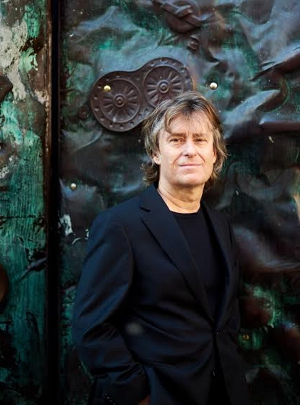Composer Anders Hillborg at the Phillips Collection
By Stephen Brookes • The Washington Post • March 11, 2017
Not to stereotype or anything, but are Swedes the most civilized people on the planet? Thoughtful, open-minded, reasonable to a fault, they may not always set the world on fire, but they contribute more than their fair share of sanity to the global psyche. So perhaps it wasn’t surprising that Thursday night’s smorgasbord of chamber music by Anders Hillborg — part of the Phillips Collection’s “Leading International Composers” series — was both intellectually engaging and warmly approachable, marked by a kind of playful, inclusive modernism that drew on everything from Renaissance music to the driving pulse of rock.  Anders HillborgLess bleeding-edge individualism, in other words, than an embrace of musical community — even down to the Phillips’ seating arrangement, which exchanged the usual strict rows for an intimate, communal semi-circle around the performers. And while the first work of the evening was a rather stately “Opening Fanfare” (written for the Swedish Parliament, hence the stately) played by the Axiom Brass ensemble, the sense of open-minded curiosity that runs through Hillborg’s music quickly emerged.
Anders HillborgLess bleeding-edge individualism, in other words, than an embrace of musical community — even down to the Phillips’ seating arrangement, which exchanged the usual strict rows for an intimate, communal semi-circle around the performers. And while the first work of the evening was a rather stately “Opening Fanfare” (written for the Swedish Parliament, hence the stately) played by the Axiom Brass ensemble, the sense of open-minded curiosity that runs through Hillborg’s music quickly emerged.
The 1998 “Brass Quintet,” for instance, contrasted passages of lazily smeared notes with others of punchy, hard-driving power, while two fine works for string quartet drew intriguingly from composers from Stravinsky to Bach. In the “Kongsgaard Variations” (built around the gorgeous “Arietta” theme from Beethoven’s last piano sonata, Op. 111), Hillborg channeled Beethoven’s dramatic lyricism in a free-flowing meta-style that slipped effortlessly from Renaissance dances to the ultra-modern coda that closed the work. The Calder Quartet turned in an expressive and deeply felt performance, as they did with the seven dark, meditative movements of Hillborg’s 2007 “Heisenberg Miniatures.”
The Kongsgaard Variations was, to these ears, the most revealing and impressive work of the evening. But there were other delights as well. Clarinettist Moran Katz turned in high-powered performances of several short works, from the spare staccato lines of “Tampere Raw” to the darting, birdlike gestures of “The Peacock Moment.” Her reading (with violinist Andrew Bulbrook) of "Primal Blues" was pure fun, as was “Close Up,” with taped tablas providing accompaniment.
But it may have been pianist Amy Yang who stole the show. After joining Katz in “Tampere Raw,” she delivered a jaw-dropping reading of “Corrente della Primavera.” A pianistic tour de force from 2002, the work’s scintillating, white-hot cascades of sound demand both power and exceptional lightness of touch, and Wang brought it off with effortless finesse; a memorable performance of a remarkable work.


Reader Comments